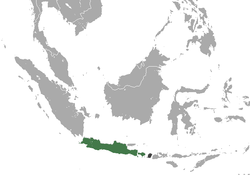| East Javan langur [1] | |
|---|---|
 | |
| Scientific classification | |
| Kingdom: | Animalia |
| Phylum: | Chordata |
| Class: | Mammalia |
| Order: | Primates |
| Suborder: | Haplorhini |
| Infraorder: | Simiiformes |
| Family: | Cercopithecidae |
| Genus: | Trachypithecus |
| Species group: | Trachypithecus cristatus group |
| Species: | T. auratus |
| Binomial name | |
| Trachypithecus auratus É. Geoffroy, 1812 | |
 | |
| Javan langur range, including both Trachypithecus auratus and Trachypithecus mauritius (green — native, dark gray — origin uncertain) | |
The East Javan langur (Trachypithecus auratus), also known as the ebony lutung, Javan langur or Javan lutung, is an Old World monkey from the Colobinae subfamily. It is most commonly glossy black with a brownish tinge to its legs, sides, and "sideburns". [3] It is found on the island of Java, as well as on several of the surrounding Indonesian islands. The Latin word auratus in its scientific name means "golden" and refers to a less common color variant. The common name golden langur refers to a different species.





